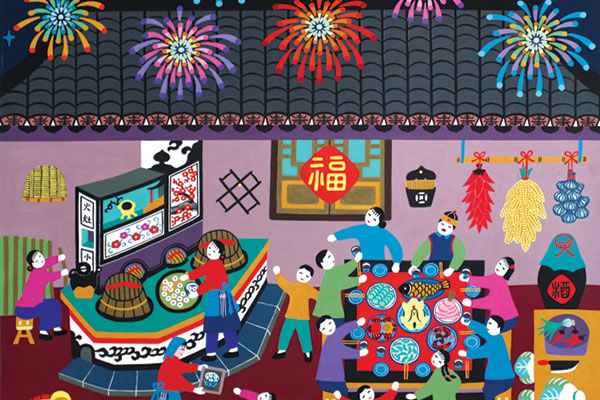Yan Junjie has not been a farmer for more than ten years, but given his current profession and its intricate ties to farming, he reckons he can be considered a peasant.
Yan is actually an artist who specializes in a very unique sort of craft that has been categorized as peasant art, which originated from the suburban Shanghai district of Jinshan. These sort of art works are typically colorful and they depict a wide range of subjects, from water town landscapes to family gatherings to distinctive elements of Chinese culture and tradition.
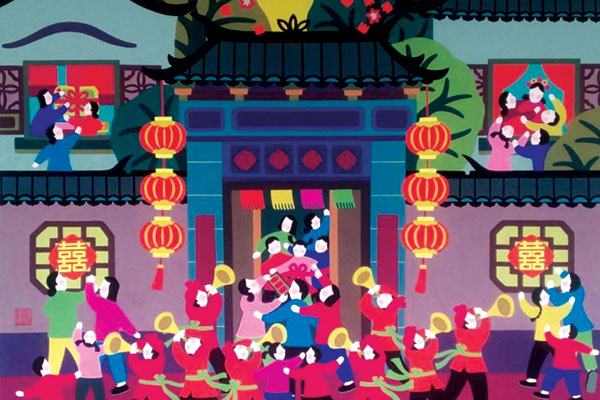
Yan and his wife Li Huihong, also an artist, now run a painting studio at a tourism center in Zhonghua village of Zhujing town in Jinshan. Their works have gained them some fame over the years. In their studio, an old photograph of Yan standing next to President Xi Jinping is placed in a prominent position for everyone to see.
“Mr Xi was the Party secretary of Shanghai when he visited us here, and I created a piece for him and his wife. He really liked it,” said Yan.
Jinshan is today so well known for producing good peasant art that Fengjing, one of its towns, built a painters’ village as a tourist and cultural attraction. Peasant art has become so deeply ingrained in the lives of Jinshan’s residents that many are starting to learn the ways of the craft from local master artists.
Yan, for example, is teaching peasant painting to dozens of children in the town.
“It’s not professional training. It’s just for children to have fun and learn about our own culture,” said Yan, who emphasized that there are no theories or guidelines to follow in peasant art.
A new art form
This art form is believed to have been popularized in the 1970s by Wu Tongzhang, an artist from Jinshan who once ran a school teaching people how to produce aesthetically pleasing folk art.
As food has always been an integral part of Chinese culture, people living in the Yangtze Delta region used to be known for decorating their kitchens with elaborate works of art. The wall behind the stove was typically where people would place their art works, and new home owners would casually request their fellow neighbors to help paint a motif on this space.
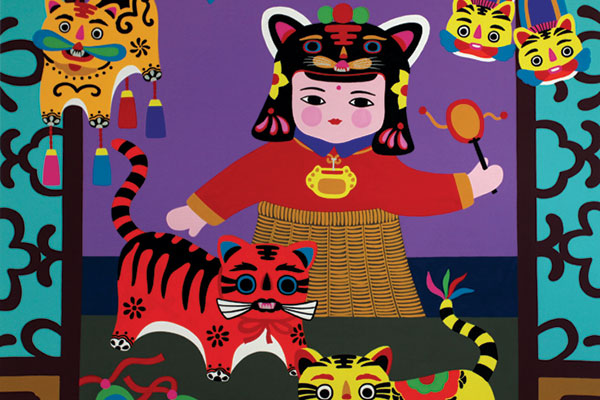
Such paintings would range from fighting scenes from ancient folklore to famous characters from Chinese fables and fairy tales. Floral patterns and other simple artistic compositions that have auspicious meanings are often painted on the lower parts of the wall in front of the stove.
Wu, a retired army officer, is said to have been so inspired by these simple works of folk art, including paper cutting and embroidery art, that he decided to gather a group of peasant artists to teach them how to paint on paper instead of walls.
“What he did was not really teaching, but more like guidance and inspiring,” said Chen Wei, one of Wu’s students who is now an advocate of peasant art as well as other cultural products of Jinshan district.
“There was this woman who only knew how to do embroidery and Wu just told her to use the pen as she would her needle and to treat the paper as a piece of silk,” Chen added.
Chen has recently brought together about two dozen paintings from peasant artists, which will be showcased at an exhibition that’s being held in celebration of the Lunar New Year. This exhibition, which is taking place at the Zhu Qizhan Art Museum in downtown Shanghai, will run from Jan 28 to the end of February.
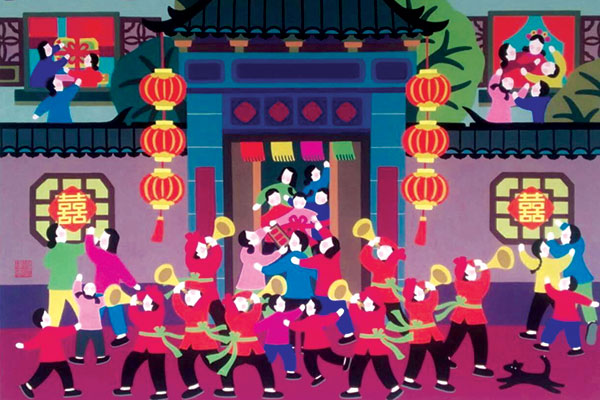
He said that peasant art is so popular these days that outstanding artists from Jinshan and their works are often introduced to celebrities from home and abroad. Such paintings have also been popular with international collectors too, as Chen said they offer a completely different alternative to the art that people are normally familiar with.
“Peasant art mostly comprise bright colors and depict joyful atmospheres, so they are quite appropriate for the New Year,” said Lu Xing, a spokesperson of the museum, who added that peasant paintings from Jinshan featuring the horoscope animal of the year have been a regular fixture at their Chinese New Year exhibitions every year since 2004.
Blending modernity with tradition
Today, peasant artists from the younger generation are seemingly looking to infuse contemporary elements into this traditional art form. Qiu Jianguo, one of the more successful peasant artists who runs his own studio in Zhujing town in Jinshan, has created pieces illustrating the urban landscape of Lujiazui, as well as the contrast of old buildings and new skyscrapers along the Huangpu River.
Qiu is also experimenting with the pointillism technique, the method of creating images using distinct dots of different colors. Qiu said he was inspired by Vincent Van Gogh, and this is just one of many styles he plans to attempt.
Meanwhile, Yan has turned to the root of peasant art for inspiration. One of his signature series involves the Chinese horoscope animals. While his use of lines and shading shares much in common with paper-cutting, the colors and compositions are much like those found in traditional blue-print cloth.
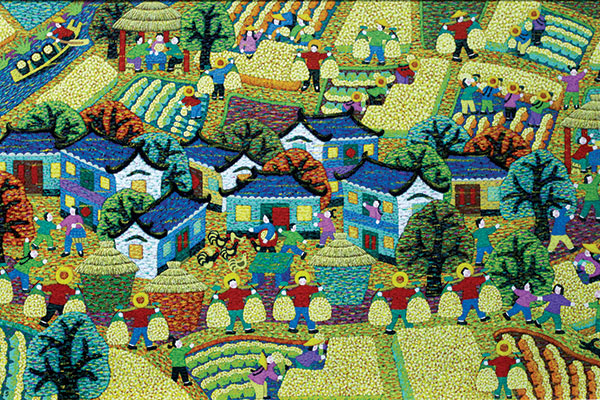
Besides painting on paper, artists like Qiu and Chen are also producing art works on ceramic plates. In the village of Shantang, located in Jinshan district’s Langxia town, this new form of peasant art is thriving. Liu Jian, a potter from Longquan, a town in Zhejiang province famous for its ancient green porcelain art, has brought his ceramic studio to Shantang to capitalize on the boom. Liu uses a refurbished old school house as a showroom for his porcelain works.
Chen will often lead visitors to this school house before sharing with them the development plans and culture of Jinshan-which is also home to an industrial zone-over a cup of tea.
“We are hosting our first marathon event in the coming spring. Athletes will be running along roads lined with beautiful trees,” said Chen.
Some of the activities that visitors from downtown Shanghai can currently do in Jinshan is picking strawberries and enjoying local food that is cooked using old-style stoves that require firewood.
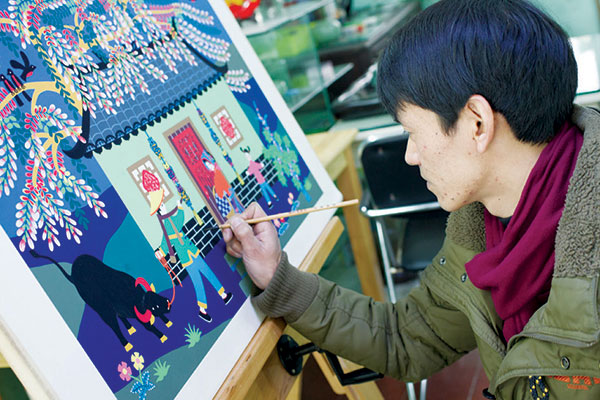
Chen added that the residents are hoping the government will develop Jinshan as a cultural enclave filled with flower farms and orchard gardens, though he conceded that one of the challenges faced by Jinshan now is the lack of tourist accommodation.
“We’re going to need nice hotels or bed and breakfast services. This is a nice vacation spot that’s only a 40-minute drive from downtown Shanghai,” said Chen.
“We’d also like to see people come and buy a holiday home here. Then for the rest of the year, the home can be leased as a B&B business. It’s a good investment.”
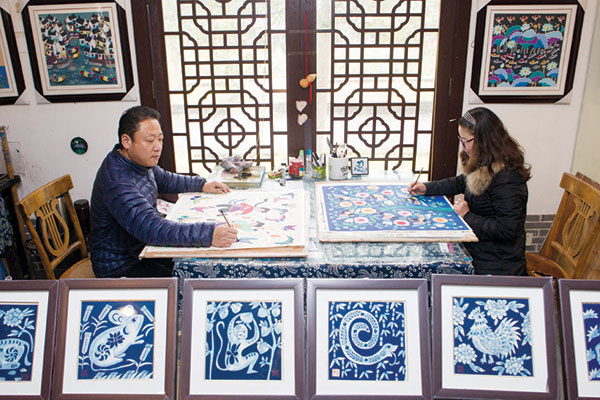
Yan Junjie and his wife are representative young artists in Jinshan. Peasant art is known for its vibrant colors and depiction of traditional Chinese culture and values.[Photo/China Daily]
